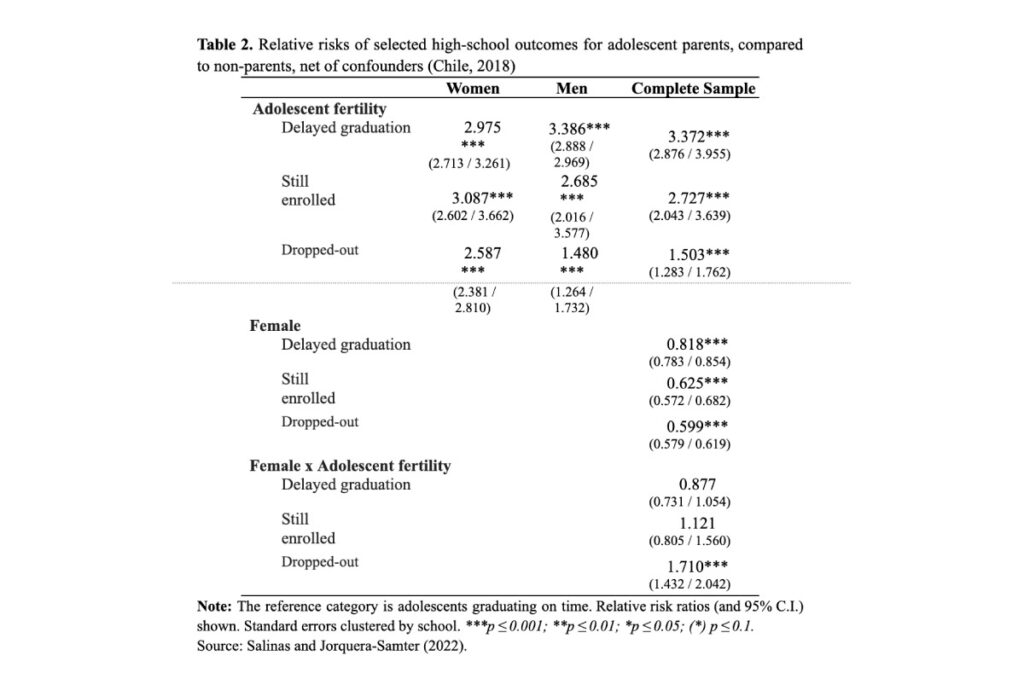The case of Chile
February 13, 2023 Viviana Salinas and Valentina Jorquera-Samter
How does adolescent fertility affect high school completion for boys and girls in Chile? Controlling for socioeconomic and academic selectivity, Viviana Salinas and Valentina Jorquera-Samter find that a teenage mother is 13% less likely to complete high school, whereas the corresponding probability decline for a teenage father is 3%.
Social sciences have a long-standing interest in the consequences of early parenthood on different domains of the life course. Early studies showed that adolescent fertility reduced educational attainment and consequently sent teenage mothers on a path of precarious employment and low income (Card, Wise, and Morgan 1987; Moore and Waite 1977; Waite and Moore 1977). Researchers soon noticed that teenagers who get pregnant form a selected group, typically with limited socioeconomic resources and poor school performance. These characteristics, and others of the same nature, tend to favor both adolescent fertility and poor educational outcomes. Failing to account for this overestimates the adverse effect of adolescent fertility on education (Diaz and Fiel 2016; Kane et al. 2013).
Assessing the effect of adolescent fertility on education in Chile
Several techniques have been developed to properly estimate the effect of adolescent fertility on education, taking into account selectivity (or “treatment selection”, in the jargon of causal inference). In a recent study (Salinas and Jorquera-Samter 2022), we employed one of these techniques (propensity score weighting) to estimate the effect of adolescent fertility on the probability of completing high school, net of selection due to the socioeconomic origin and prior academic performance. While most previous research on this topic focuses on girls and the U.S., we studied Chile, we included boys, and we tested explicitly for gender differences.
Besides, we exploited an innovative data source. While the few estimations that exist for Latin America rely on surveys, we used register data from the Ministry of Education covering a cohort of students attending publicly funded schools from 2011 to 2018.
In Chile, adolescent fertility (births to women aged 15-19 years) has declined sharply in recent years, from 53 per 1,000 in 2008 to 23 per 1,000 in 2018 (Rodriguez Vignoli and Roberts 2020). This is largely below the Latin America average (61 per 1,000 in 2020). Besides, high-school enrollment is high and dropout rates are relatively low (Ministry of Education of Chile 2020). In 2020, the completion rate for upper secondary education (12 years of schooling) was 85.8% in Chile, as compared to 63.7% in Latin America as a whole (UNESCO 2022).
Does adolescent fertility affect the probability of high school completion differently for girls and boys?
Our estimates of the effect of adolescent fertility on the probability of completing high school are shown in Table 1. After dealing with the selectivity of origin in terms of socioeconomic status and prior academic performance, we find that a teenage girl who experiences adolescent fertility is about 13% less likely to complete high school, whereas the corresponding probability decline for a teenage boy is only 3%. The introduction of an interaction term in the pooled sample confirms that this effect is different by gender.

Adolescent fertility affects not only the probability of completing high school, but also the probability of delaying graduation, dropping out, and is still enrolled in the system three years past the expected graduation time, for both genders (table 2). All of these negative outcomes are between 1.5 and 3.4 times more likely for adolescent parents. However, as seen in the results for the pooled sample, significant gender effects of adolescent fertility are detectable only on the probability of dropping out, which is higher for adolescent mothers than adolescent fathers.

Conclusion
In short, the detrimental effects of adolescent fertility on educational performance are strong in Chile, for both genders, and on a couple of relevant outcomes (high school completion and risk of dropping out) they are larger for girls than boys. Note that these are net effects, everything else equal, including, for instance, socioeconomic origin and prior academic performance.
From a policy perspective, these results indicate the need for policies aimed at preventing adolescent fertility, in the first place, and, failing that, at human capital recovery for teens who drop out of school after becoming parents.
References
- Card, J.J. and Wise, L.L. (1987). Adolescent Mothers and Their Children in Later Life. Family Planning Perspectives 19(4):142–151. doi:10.2307/2135159.
- Diaz, C.J. and Fiel, J.E. (2016). The Effect(s) of Teen Pregnancy: Reconciling Theory, Methods, and Findings. Demography 53(1):85–116. doi:10.1007/s13524-015-0446-6.
- Kane, J.B., Morgan, S.P., Harris, K.M., and Guilkey, D.K. (2013). The Educational Consequences of Teen Childbearing. Demography 50(6):2129–2150. doi:10.1007/s13524-013-0238-9.
- Moore, K.A. and Waite, L.J. (1977). Early Childbearing and Educational Attainment. Family Planning Perspectives 9(5):220–225. doi:10.2307/2134432.
- Rodriguez Vignoli, J. and Roberts, A. (2020). El descenso de la fecundidad adolescente en Chile. Antecedentes, magnitud, determinantes y desigualdades. Serie de Estudios INJUV. https://www.injuv.gob.cl/sites/default/files/estudioembarazo.pdf
- Salinas V. And Jorquera-Samter V. (2020) Adolescent fertility and high school completion in Chile: Exploring gender differences, Demographic Research, 47(31): 967–1008. Doi: 10.4054/DemRes.2022.47.31
- UNESCO. (2022) Education in Latin America and the Caribbean at a Crossroads. https://www.unicef.org/lac/media/37791/file/Education%20in%20Latin%20America%20and%20the%20Caribbean%20at%20a%20crossroads.pdf
- Waite, L.J. and Moore, K.A. (1977). The Impact of an Early First Birth on Young Women’s Educational Attainment. Social Forces 56(3):845–865
No comments:
Post a Comment